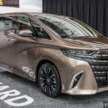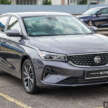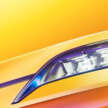The fourth-generation Toyota Alphard (and its Vellfire twin, which we’ve covered in a separate post) has been officially launched in Malaysia. UMW Toyota Motor (UMWT) is once again providing two options for the country’s most popular luxury vehicle – the Alphard in Executive Lounge (EL) spec and the ‘entry-level’ Vellfire. This post looks at the Alphard 2.4T Executive Lounge, which is yours for RM538,000 on-the-road without insurance.
That’s RM100,000 more than the Vellfire 2.5L, but you do get a lot more. The biggest change from the previous template, aside from the use of the GA-K version of the Toyota New Global Architecture (TNGA) platform, is a turbo engine to replace the familiar 3.5-litre V6.
TNGA x Turbo
Of late, Toyota has been using its 2.4-litre turbo-four to replace the big naturally-aspirated V6 in its larger models (more efficient, less emissions), and the Alphard gets this generational change. The T24A-FTS makes 278 PS and 430 Nm of torque from 1,700 to 3,600 rpm. The Dual VVT-i unit is paired to an eight-speed Direct Shift conventional automatic gearbox with manual mode.
If you’re wondering, the 2GR-FE 3.5-litre V6 from the previous AH30 generation made 271 PS and 340 Nm at 4,700 rpm, so we’re looking at a big difference of 7 PS and 90 Nm, and with all of that torque made much lower in the powerband too. The V6 was mated to a six-speed auto, so we gain two extra ratios here. The 2,235 kg Alphard 2.4T’s top speed is 180 km/h and claimed fuel consumption is 9.0 litres per 100 km. Auto start-stop is standard and there’s an ECO drive mode.
Speaking of powertrains, in Japan, the latest Alphard is available with a 2.5L NA engine (as per our Vellfire), and a series-parallel hybrid that pairs a Dynamic Force engine (specifically the A25A-FXS 2.5L NA with 190 PS/236 Nm) with an e-motor with 182 PS/270 Nm. Total system output for the HEV – which we covered at GIIAS 2023 – is 250 PS. In Japan, there’s also an E-Four version that adds a 54 PS/121 Nm e-motor at the rear axle.
It has to be noted though that we’re getting an unusual combo. In Japan, the Alphard is only available with the 2.5L NA and HEV, while the Executive Lounge is hybrid-only. There, the sportier-flavoured Vellfire (no EL option) gets two engine choices – HEV and turbo. Perhaps it’s due to the Alphard being given a higher positioning by UMWT, but we get inverse combos – Alphard turbo, Vellfire NA.
Also, since the Vellfire is the sportier twin, its suspension gets a front performance brace and the tyres are UHP Dunlops. Those are all in place to match the output from…. the most junior engine and a CVT. No hybrid in a country where petrol is cheaper than Coke – and where Alphard drivers idle most of the day without a care about FC – is understandable though. The hybrid is sold in both Thailand and Indonesia, by the way.
Maxed out in size
Let’s move on. The AH40 might be immediately recognisable as an Alphard, but it’s all-new underneath with the TNGA platform. Dimensions wise, the Alphard is a touch longer than before at 5,010 mm, but the 1,850 mm width and 3,000 mm wheelbase are unchanged. Ditto the height, which tops out at 1,950 mm.
Why didn’t they go bigger? The Alphard may be ubiquitous on our roads, but it’s primarily a model for Japan. The box on wheels needs to fit standard automated parking systems in its home market, so this is the limit. However, interior space between the front and second-row seats, and between second- and third-row seats, are up by 5 mm and 10 mm respectively.
Toyota claims more comfort and a better drive. The new Alphard features straight rockers and a V-shaped brace in the rear for a 50% improvement in rigidity. Toyota also optimised the use of structural adhesives to limit deformation of the body and achieve ‘outstanding manoeuvrability and stability’.
Ultimate comfort is the mission here, and measures like the use of rubber bushings in the attachment portions of the cushion frames, and memory foam in the seats, combine for approximately 30% reduction in vibration.
Clean and classy cockpit
The outgoing Alphard is already a very luxurious machine but this one takes things a step further. And it’s a big step. Before heading to the main hall, let’s take a look at the cockpit, which is very Lexus in design and even materials. All touch points are covered in smooth and soft material, and the ‘Premium Nappa Leather’ is discernibly more supple than the synthetic leather in the Vellfire.
Your chauffeur (or yourself during the weekends) will be looking at a 12.3-inch digital instrument panel and head-up display, but the dashboard’s centrepiece is the 14-inch touchscreen that integrates AC (auto with Nanoe X) and seat ventilation/heating controls. From the previous-gen’s UMWT double-DIN, this factory unit is leagues ahead in both function and appearance. There’s Apple CarPlay and Android Auto connectivity, wireless charging and a 15-speaker JBL sound system.
The steering wheel has woodgrain trim, heating and powered tilt/telescopic adjustment with memory. New to this generation and exclusive to the Alphard in Malaysia (meaning not available in the Vellfire) are electrostatic switches and paddle shifters. The steering controls are minimal, just like the very clean centre console, which aside from the head unit/AC, has only a few driving-related buttons behind the gear lever.
Another upgrade over the previous car is the digital rear view mirror, which is fed by a discreetly integrated camera above the rear Toyota logo. Lastly, the driver’s seat is eight-way powered with memory while the front passenger chair is four-way powered, both with heating and ventilation. The driver gets all kinds of views to assist in parking, and you can choose the colour of the avatar to match your Alphard’s colour. UMWT has added front and rear dashcams.
The ultimate luxury machine
What a plush workspace for the driver, but an Alphard is all about the VIP seats in the rear. They’re all seven-seaters, but the Executive Lounge’s chairs are wider, which means that you’ll need the electronic slider to access the third-row seats, which flip up to the side 50:50 when not in use, like in old school 4x4s. In the Vellfire, it’s still possible to squeeze through the two captain chairs.
Captain chairs. You hear that term quite often these days when it comes to individual middle row seats, but if this writer was a product guy, I won’t call the Alphard’s seats that. Surely the captain of the plane doesn’t sit as well as a passenger in first class?
The Alphard EL seats are majestic. Functions that you won’t find on the Vellfire’s narrower ottoman seats are detachable phone-like remote controls (audio, climate, 64-colour roof lighting, seats), a table with vanity mirror that is stowed in the armrest (Vellfire gets a shared flip-up tray between the seats) and relax power recline with massaging function.
Adding greatly to the airplane-style sense of occasion are the glass roof panels, bisected by a panel that has a 14-inch screen, two flip-down sunglass bins, lights, controls and air con vents. This means that each VIP seats gets its own (fixed) roof glass panel with shade. Speaking of shades, the electronic side window shades come down instead go up – a small thing that I find really cool. No more sunroof for the driver in this generation.
There’s no shortage of charging and storage spaces. Below the inner armrest is a USB-C port and a bin for bottles/drinks. The outer armrest has a flip-open cupholder if you want your beverage at arm level. Behind the cockpit’s centre console lies AC vents, an AC plug and a bin. Below the front seats are slim trays that I can imagine “hotel slippers” in. Last but not least, the Alphard-exclusive ‘Quiet Sliding Door’ is truly more silent in operation compared to the regular door – we compared them.
There’s nothing much to say about the third-row seats other than the fact that technically, this is a bench for three people and the Alphard is a seven-seater. It’s best for two though, and occupants have their own USB-C ports (seven in total), cupholders and electronic sunshades. And a big reason to be envious of those in front.
Safety as you’d expect
As the AH40 Alphard is a high-end model that’s just a few months old in Japan, you’d expect it to come with the latest safety features and it does. The Toyota Safety Sense 3.0 driver assist suite includes Pre-collision System (PCS), Lane Departure Alert (LDA), Dynamic Radar Cruise Control (DRCC) with Lane Tracing Assist (LTA), Road Sign Assist (RSA) and Adaptive High-beam System (AHS).
Those features are supplemented by Blind Spot Monitor (BSM) with Rear Cross Traffic Alert (RCTA), six airbags, a tyre pressure monitoring system and Isofix child seat mounts. By the way, the headlamps are tri-LEDs with sequential signals (rear too), cornering lamps and daytime running lights. UMWT’s standard issue dashcam (front and rear), vehicle telematics system and solar/security window film are included.
Alphard or Vellfire?
Finally, the design differences between the Alphard and Vellfire. The Alphard sports a much large grille than before, filled with armour plating-style inserts and chrome accents, nicely integrated with distinctive LED daytime running light signatures that are like dash lines. The dash lines motif is found on the tail lamps too, with a downturned chrome strip linking them. Alphard is spelled out prominently above the number plate, like on the Camry.
The side profile of the box sports a prominent beltline that looks like a ‘Z’. It’s at this Z intersection that you find the traditional Alphard logo, which used to be on the front grille. That spot is now taken by the Toyota emblem, which means that the only places you’ll find the Alphard logo is on above-mentioned pillar and the key fob.
The Vellfire’s face has its grille area filled with horizontal slats from top to bottom, and its ‘jaw’ is square and prominent thanks to a chrome border, which is repeated at the rear bumper. The Vellfire’s signature split headlamps have been retained, and the rear lighting is completely different from the Alphard’s – here, the pattern is a ‘double-U’ with a full-width light bar. The latter is traced by a straight chrome line (Alphard’s chrome trim is contoured). The Vellfire gets its own V logo on the B-pillar and key fob.
No difference in the 19-inch two-tone wheel design, but the 225/55 tyres are different – Michelin Primacy SUV+ touring tyres for the Alphard and Dunlop SP Sport Maxx UHP rubber for the Vellfire. As the sportier twin, the Vellfire also gets a front performance brace that connects the radiator support and side members for extra rigidity.
The sporty one also comes with an all-black interior theme, from the seats to the dashboard, pillars and headlining. The Alphard gives you a choice of that safe option, or the warmer combination of black (headlining and upper dash), brown and beige upholstery that you see here. As for exterior colours, the Precious Leo-Blond paint in our pics is exclusive to the Alphard. The three other shared colours are pearl white, silver and black.
Once again, the Alphard 2.4T Executive Lounge is priced at RM538,000 on-the-road without insurance, RM100,000 costlier than the Vellfire 2.5 at RM438,000. Buying these CBU Japan imports from official importer UMWT will get you a five-year unlimited mileage factory warranty and reliable after-sales support. What do you think of the Alphard as a luxury business machine versus big sedan limos like the BMW i7?
@paultancars Para tauke dan VIP, #Toyota #Alphard dan #Vellfire baru dah sampai! #paultancars #paultan #carsoftiktok #cartok #cartiktok #malaysia #viral #trending #fyp #foryou #foryoupage ♬ original sound – Paul Tan’s Automotive News
Toyota Alphard spec sheet; click to enlarge
GALLERY: 2024 Toyota Alphard 2.4T Executive Lounge
GALLERY: 2024 Toyota Alphard 2.4T Executive Lounge official photos
The post 2024 Toyota Alphard launched in Malaysia – 4th-gen AH40 with 2.4 Turbo 8AT, Executive Lounge, RM538k appeared first on Paul Tan’s Automotive News.




